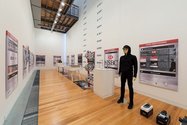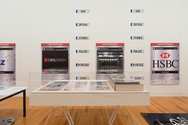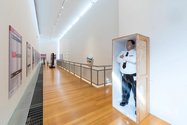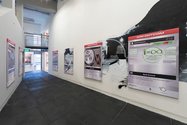Alice Tappenden – 7 November, 2014
Like a silent co-conspirator, Simon Denny is both everywhere and nowhere in The Personal Effects of Kim Dotcom. At his artist talk, Denny seemed to shy away from stating his personal opinion of Dotcom, and made clear that he had deliberately avoided contact with his subject. Effectively, he places the onus on the audience to make their own judgements - however, his artistic decisions seep quietly into the framework he's provided.
Wellington
Simon Denny
The Personal Effects of Kim Dotcom
4 October - 19 December 2014
“That’s the funny part of all this … Everyone thinks they know me. But nobody really knows me at all.”
- Kim Dotcom to Charles Graeber (Wired Magazine)
On New Year’s Eve 2010, a story was published in the New Zealand Herald under the headline ‘Dark horse to light up New Year.’ The dark horse in question is now well known to New Zealanders as Kim Dotcom, but at this stage he was just referred to as a ‘jet-setting German businessman with a chequered past of computer hacking and insider trading’, and more notably, ‘Kim Schmitz, who calls himself Kim Dotcom’ (my italics). Though the journalist makes no mention of it, Dotcom was celebrating - he’d just been granted New Zealand residency. As such, he treated Aucklanders to a ten-minute fireworks display over Waitemata harbour - a gift reported to have cost $500,000. Later that night, as the fireworks exploded, Dotcom hovered in his helicopter over the city, watching the spectacle from just 200 metres away.
Four years later, and the man formerly known as Kim Schmitz has been - publically, at least - subsumed by the brand Dotcom. Since the infamous raid on his Coatesville mansion in January 2012, he has entered our cultural and political landscape as someone perceived at various times as a champion for Internet freedom; a self-serving, corrupt criminal; a cult hero of the gaming world; and a bombastic billionaire with flash cars and beautiful women at his disposal. Now, Berlin-based New Zealand artist Simon Denny has brought his exhibition The Personal Effects of Kim Dotcom to Wellington’s Adam Art Gallery for its third iteration, engaging with the man and the brand through a list of 110 possessions seized in the raid by the New Zealand Police, acting on behalf of the FBI.
Each item on this freely available ‘Property Subject to Forfeiture’ list is represented in a series of large canvases that fill nearly every available wall space of the Adam’s three floors, including the lift, the stairwell, and even the toilets. In a fitting reflection of Dotcom’s magnified presence here in New Zealand, they’re significantly larger than the Vienna (July 2013) and Colchester (March 2014) exhibitions’ small plaques. Designed with the aesthetic of Dotcom’s brand in mind, each canvas follows the same formula, and includes an item number, an image of the object or a suitable representation (often scraped from the Internet, resulting in variable quality), a category (e.g. ‘Vehicle’, ‘Bank Account’, ‘Consumer Electronics’) and a description taken from the seized property list. ‘Megavid.eu’ sits at the bottom left, representing the limited liability company Denny established for the project, and a mouse icon hovers over the product, enticing viewers to mentally click. The canvases don’t just remind me of apps, but of an older form of bought, traded, stolen and bargained property - collectable playing cards. Visually, they’re useful tools to convey the extent of Dotcom’s empire; and as one moves through the gallery’s various spaces, their sheer quantity is indeed staggering.
Alongside the canvases is a selection of objects representing some of the list’s items. They’re not placed in numerical order, aren’t labelled, and are often interpretations of the list rather than exact replicas - Michael Parekowhai’s Kapa Haka (Hīwera) to stand in for an anonymous fiberglass sculpture is one particularly inspired choice - which leads visitors to constantly refer to the exhibition’s own object list in an attempt to match article with description. The process of discovering what the FBI and New Zealand Police determined relevant to their investigation is fascinating and often bewildering - a pile of shredded currency valued at $175,000,000 and a vast number of bank accounts are obvious targets, but just what eight televisions of varying sizes, a Predator statue and a Christian Colin sculpture would help with is anyone’s guess. The labyrinthine visualisation of the list leads viewers on their own detective trail of sorts, becoming more and more embroiled in a world they might have imagined, but not been able to fully comprehend.
The list, of course, only tells one version of the Kim Dotcom story. As a man known for - perhaps even defined by - his possessions (Hummers; giraffe statues; golf carts; the ‘Dotcom Mansion’ sign) and even his clothing (zip-up black hoodies; leather caps; blue-tinted Cartier sunglasses), it is interesting to consider whether The Personal Effects of Kim Dotcom intends to subvert or enhance the Dotcom brand. While the exhibition’s title hints at intimacy, there is very little in the canvases, or the objects Denny has chosen to add (including a collection of New Zealand Herald articles, a MegaUpload promotional video and a Hästens bed sample) that reveals anything “real” - for want of a better word - about Kim Schmitz’s private life.
Dotcom’s brand is even so powerful that it actually subsumes other key players in the game. Take, for example, the names Finn Batato, Julius Bencko, Sven Echternach, Andrus Nomm, Mathias Ortmann and Bram van der Kolk, under which several of the seized bank accounts are registered. Visitors I’ve spoken to assume that like ‘Kim Tim Jim Vestor’ these are more of Dotcom’s pseudonyms. However, the six men were in fact his partners in MegaUpload and are his co-defendants in the US Department of Justice’s case. Three (Batato, Ortmann and van der Kolk) still reside at the Dotcom mansion in New Zealand and one (Bencko) even remains at large, but despite this, they’re barely mentioned in our news media. The question remains, then: if Dotcom can subsume these guys, can he do the same to Simon Denny?
Like a silent co-conspirator, Simon Denny is both everywhere and nowhere in The Personal Effects of Kim Dotcom. At his artist talk, Denny seemed to shy away from stating his personal opinion of Dotcom, and made clear that he had deliberately avoided contact with his subject. Effectively, he places the onus on the audience to make their own judgements - however, his artistic decisions seep quietly into the framework he’s provided. Nowhere is this more apparent than in the objects he’s chosen to include that don’t feature on the official forfeiture list. It is these items that most obviously give away his research - asking his father to cut out Dotcom-related clippings from the New Zealand Herald, for example, or deliberately including the Hästens bed sample and promotional video (the origins of the £64,000 bed are discussed at length in Wired‘s fascinating profile of Dotcom). Throughout the exhibition, too, are re-creations of the graffiti wall that adorns Dotcom’s gaming room, executed by the Cut Collective, Ed Bats, and Sean Duffell. While at times these border on overkill, they are effective in the Kirk gallery - the commando figures I assume are from Dotcom’s gaming world storm through the darkened space, reminiscent of a bunker or panic room: the very place Dotcom went when his mansion was raided.
While the conversation has again shifted to subject over artist, Denny’s brand is also at stake. ‘Megavid.eu’ is, after all, his company, and we shouldn’t forget that these canvases are highly reminiscent of his recent Walters Prize exhibition All You Need is Data - The DLD 2012 Conference REDUX (2013) as well as Dotcom’s aesthetic. As one of the most successful exports from New Zealand’s current crop of emerging artists, Denny has worked hard at developing his own brand - and he’s now become closer to the halls of art world power, with his dealer Daniel Buchholz recently named as Art Review‘s 67th most powerful figure in the art world. Whether his engagement with, and leveraging of, powerhouse brands of the tech world (TED and Samsung, for example) will become fully cemented as the Denny brand is yet to be decided - but as Secret Power, his Venice Biennale exhibition draws nearer, his investigations into authority, identity and the currents of capital seem unlikely to abate. It’s hard to imagine a better starting point than Kim Dotcom.
Alice Tappenden








 Advertising in this column
Advertising in this column Two Rooms presents a program of residencies and projects
Two Rooms presents a program of residencies and projects

This Discussion has 0 comments.
Comment
Participate
Register to Participate.
Sign in
Sign in to an existing account.